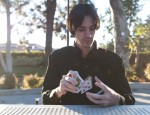The original version of this article contained multiple errors and has been changed. See the bottom of the article for additional information.
For an hour each day, Jeremy Gleick sets aside his biochemistry and neuroscience textbooks and picks up playing cards, juggling balls and sometimes even knives.
“(Learning something new each day) is an opportunity to get to do something I ordinarily would not be able to do,” Gleick said.
For about 3 1/2 years, the third-year neuroscience student has spent one hour every day, trying to learn something new outside of his regular course load.
“It started out as a philosophical question: what am I doing here and why? I figure, for now, I’m here to learn,” Gleick said. He started what he calls his “learning hour” when he was a senior at Berkeley High School in Berkeley, Calif.
During the hour, he devotes his full attention to something that interests him, whether it’s a lecture about psychology, blacksmithing or how to juggle. To keep track of what he learns, he said he records each hour on a spreadsheet on his computer.
He mostly decides what to learn spontaneously, and may spend more than one hour learning something, depending on the difficulty of the topic and his level of interest. He has spent 39 hours learning about the Civil War, 33 hours learning philosophy and 19 hours learning American Sign Language, among several other activities.
In the years he’s been doing his learning hour, Gleick said he has tried to incorporate what he learns into his everyday life.
Once, while walking home with Erin Sterling, a third-year English student, from the Great Dickens Christmas Fair, an event in San Francisco that recreates Victorian London with food, entertainment and costumes, Sterling began complaining that her feet hurt.
Gleick, having learned hypnosis over a series of learning hours, saw an opportunity.
“You know, I can make that go away (with hypnosis),” he said to Sterling.
But Sterling was skeptical, she said. The impromptu psychological spell didn’t end up curing her aching feet, but she said she did feel like she was about to fall asleep.
Sterling and Gleick met in an improv live-action role-play group back when they were both in high school. She’s seen Gleick’s progress since the beginning of his learning endeavor.
“I think (the learning hour) is really neat,” she said. “I don’t have the willpower to do something like that.”
Gleick’s willpower hasn’t always been so strong.
“In the beginning, I missed days – even a week – because I was particularly busy,” he said. “After a couple of months, though, it started becoming a part of my routine.”
He said he continues doing the learning hour because he enjoys it, and because he does not want to break his 3 1/2-year streak.
“Sometimes it’ll get really late, like 1 a.m, and I’ll have class at 8 a.m., but I’ll still do my learning hour,” Gleick said. “Actually, I think that happened last night,” he added, laughing.
Sometimes, his learning hour activities overlap with one another, he said. Skills he learned in gymnastics have helped him with wushu, a type of Chinese martial arts, he said.
Gleick’s wide range of interests both intrigue and puzzle many of his friends.
“He’s all over the place,” said Jules Robins, a second-year physics student and Gleick’s friend, with a chuckle. Robins said Gleick has taught him about polar bear hunters up north, Hindu mythology and even neuroreceptors in the brain.
Gleick said he learns from all different kinds of sources, such as group classes, private lessons and online tutorials, depending on the time and topic of the day. Gleick said he also learns from YouTube videos and iTunes U, an online platform that offers lectures from various universities. His favorite course from iTunes U is still the first one he listened to: an introductory psychology course by a professor from the Massachusetts Institute of Technology, Gleick said. He advised Sterling to watch the lecture before taking an introductory psychology class at UCLA, and she said it made the class much easier.
Robins said he thinks the learning hour is a great idea, and hopes to start doing it at some point in the future.
“The thing that separates Jeremy from people like me, who are interested in everything, is that he actually goes out and tries whatever it is he is interested in,” Robins said. “He doesn’t just contemplate doing it.”
Gleick’s advice for someone interested in pursuing the learning hour was to start slowly before doing it every day, because the initial commitment may seem daunting, he said.
Sterling said she thinks Gleick’s learning hour only broadens his scope of learning, even if he doesn’t always delve deeply into every topic.
“Jeremy doesn’t always finish projects, but he always is interested in what he’s doing,” she said.
His latest project is to learn how to play percussive guitar mostly through the Internet, which he said sounds more impressive than regular strumming, even though it isn’t much more difficult.
He is currently on track to become a researcher in neuroscience, though he wants to write fiction, write music and intends to travel in the process.
But regardless of whether his career goals change, he hopes to continue learning new things through his learning hour, he said.
“I’m interested in finding unusual methods to do usual things,” he said.
Email Levin at ylevin@media.ucla.edu.
Correction: Wushu is a type of Chinese martial arts. Also, Gleick’s favorite course from iTunes U is an introductory psychology course by a professor from the Massachusetts Institute of Technology.

I feel like I heard about this guy on Reddit